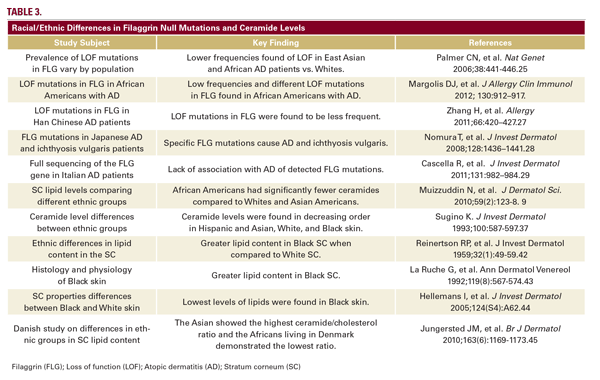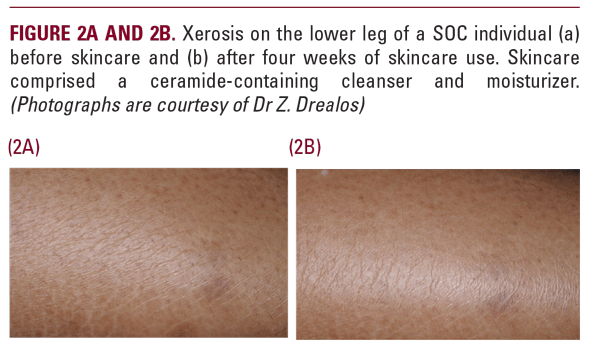
contribute to barrier dysfunction and disease.
Additional robust studies with well-defined racial/ethnic groups and phototypes are needed to validate these findings (Table 3).
4. Black patients are disproportionately affected with pruritus and related conditions such as atopic dermatitis and prurigo nodularis. Black skin may have several unique structural properties related to the pathogenesis of pruritus, including decreased ceramide levels, variations in TEWL, and larger mast cell granules.
The published literature suggests that Black patients are more likely to present with pruritus than White patients and are also more likely to be diagnosed with prurigo nodularis and atopic dermatitis.46 As mentioned previously, data on TEWL in Black skin compared to other racial groups is conflicting. However, data suggesting reduced ceramide content in black skin has been consistent across studies. Both of these factors (TEWL and ceramides) may contribute to xerosis, pruritus, and related conditions. Variations in mast cell composition have also been demonstrated in Black skin, such as larger mast cell granules that may be functional.47 Notably, pruritus can be associated with malignancy, and in Black patients, these underlying malignancies are more common soft tissue, dermatologic, and hematologic malignancies.48 With this association, it may be prudent to consider screening Black patients for underlying malignancy when presenting with new-onset pruritus later in life.
5. There is a need for robust clinical studies to understand and quantify ethnic differences in skin properties, including the complex relationship between skin permeability and other characteristics.
While racial/ethnic differences in barrier structure and function have been reported, they are based on a relatively small number of studies with many conflicting results. Interpretation and application of these data are limited by small sample sizes, varying methodologies, heterogeneous definitions of racial/ ethnic groups, and lack of standardization of baseline skincare regimens.
Additional, more robust studies with clearly defined comparative populations are needed to better inform optimal skincare recommendations for the diverse spectrum of populations with skin of color. Future research should focus on reducing gaps in our understanding of skin barrier properties across diverse populations and their implications for skin health and disease.
6. Diversity of skin properties and cultural perceptions of skin, such as "ashy skin" in Black populations and sensitive skin in East Asian populations, should be considered in developing and selecting skincare products.
In Black populations, dry skin can be culturally stigmatizing. Xerosis on the background of richly pigmented skin can have a grey or ashen appearance and is often referred to as "ashy skin" in the Black community (Figure 1). Although in all ethnicities dry skin can be present, in Black skin it is more visible and has greater cultural significance due to its aesthetic appearance. Daily moisturization is considered a cultural norm in the personal care practices of Black patients. The frequency and selection of moisturizing products vary between ethnic populations based on cultural and environmental factors (Figure 2a and Figure 2b).
Asian skin is often referred to as more "sensitive",49 but understanding this perception becomes a bit more challenging. Structural differences do indeed exist that are seeming consistent across multiple studies, but it should be noted that it is difficult to draw generalizations across all East Asian populations, which together encompass a large proportion of the global population.
In multiple studies, it was confirmed that TEWL increased more with tape-stripping in Asian skin versus other groups,9,36 supporting the relative weakness of the skin barrier, which may lead to a perception of sensitivity. The mechanism for this has been hypothesized to be either the reduced thickness of the stratum corneum or increased sweat gland density.50 However, another test using a different technique, applying sodium lauryl sulfate to the skin as an irritant, found that TEWL remained the same among Japanese and European women.51 Interestingly, in this study, Japanese women still reported higher intensity of subjective sensory differences with the application of skin irritants. Overall, most evidence points to Asian skin having higher TEWL and skin reactivity/sensitivity.52
All in all, some objective measures support that there may be some structural differences in Asian skin, leading to a perception of sensitivity in this population. However, further studies in larger and better-defined populations in the Asian diaspora are necessary.
Data about cultural variations in skincare or skin dryness among South Asian and Hispanic/LatinX populations are currently lacking.
Different cultural norms on skin cleansing and moisturization are also important to understand and consider when evaluating skin barrier differences and making recommendations for skincare across diverse patient populations.


In Black populations, dry skin can be culturally stigmatizing. Xerosis on the background of richly pigmented skin can have a grey or ashen appearance and is often referred to as "ashy skin" in the Black community (Figure 1). Although in all ethnicities dry skin can be present, in Black skin it is more visible and has greater cultural significance due to its aesthetic appearance. Daily moisturization is considered a cultural norm in the personal care practices of Black patients. The frequency and selection of moisturizing products vary between ethnic populations based on cultural and environmental factors (Figure 2a and Figure 2b).
Asian skin is often referred to as more "sensitive",49 but understanding this perception becomes a bit more challenging. Structural differences do indeed exist that are seeming consistent across multiple studies, but it should be noted that it is difficult to draw generalizations across all East Asian populations, which together encompass a large proportion of the global population.
In multiple studies, it was confirmed that TEWL increased more with tape-stripping in Asian skin versus other groups,9,36 supporting the relative weakness of the skin barrier, which may lead to a perception of sensitivity. The mechanism for this has been hypothesized to be either the reduced thickness of the stratum corneum or increased sweat gland density.50 However, another test using a different technique, applying sodium lauryl sulfate to the skin as an irritant, found that TEWL remained the same among Japanese and European women.51 Interestingly, in this study, Japanese women still reported higher intensity of subjective sensory differences with the application of skin irritants. Overall, most evidence points to Asian skin having higher TEWL and skin reactivity/sensitivity.52
All in all, some objective measures support that there may be some structural differences in Asian skin, leading to a perception of sensitivity in this population. However, further studies in larger and better-defined populations in the Asian diaspora are necessary.
Data about cultural variations in skincare or skin dryness among South Asian and Hispanic/LatinX populations are currently lacking.
Different cultural norms on skin cleansing and moisturization are also important to understand and consider when evaluating skin barrier differences and making recommendations for skincare across diverse patient populations.


CONCLUSION
Data on racial/ethnic differences in skin barrier structure and
function are limited but suggest variations in some characteristics
relevant to skincare. While some data are conflicting and have
methodological limitations, the body of literature indicates
that there are racial/ethnic variations in ceramide content,
stratum corneum structure, filaggrin mutations, and TEWL
(albeit varied by study and methodology). Data on barrier
properties in Hispanic/LatinX and South Asian populations are
notably lacking. Additional, more robust studies with clearly
defined comparative populations are needed to better inform
optimal skincare recommendations for the diverse spectrum of
populations with skin of color.
DISCLOSURES
The authors disclose receipt of an unrestricted educational grant
from CeraVe USA for support with the research of this work and
also received consultancy fees for their work on this project.
REFERENCES
1. Wesley NO, Maibach HI. Racial (ethnic) differences in skin properties: the objective data. Am J Clin Dermatol. 2003;4(12):843-60. doi: 10.2165/00128071-200304120-00004. PubMed PMID: 14640777.
2. Freeman RG, Cockerell EG, Armstrong J, Knox JM. Sunlight as a factor influencing the thickness of epidermis. J Invest Dermatol. 1962;39:295-8. doi: 10.1038/jid.1962.115. PubMed PMID: 13959466.
3. Mitchell RE. The skin of the Australian Aborigine; a light and electron microscopical study. Australas J Dermatol. 1968;9(4):314-28. doi: 10.1111/ j.1440-0960.1968.tb01310.x. PubMed PMID: 5708571.
4. Montagna W, Carlisle K. The architecture of Black and white facial skin. J Am Acad Dermatol. 1991;24(6 Pt 1):929-37. doi: 10.1016/0190-9622(91)70148-u. PubMed PMID: 1714469.
5. Reed JT, Ghadially R, Elias PM. Skin type, but neither race nor gender, influence epidermal permeability barrier function. Arch Dermatol.
2. Freeman RG, Cockerell EG, Armstrong J, Knox JM. Sunlight as a factor influencing the thickness of epidermis. J Invest Dermatol. 1962;39:295-8. doi: 10.1038/jid.1962.115. PubMed PMID: 13959466.
3. Mitchell RE. The skin of the Australian Aborigine; a light and electron microscopical study. Australas J Dermatol. 1968;9(4):314-28. doi: 10.1111/ j.1440-0960.1968.tb01310.x. PubMed PMID: 5708571.
4. Montagna W, Carlisle K. The architecture of Black and white facial skin. J Am Acad Dermatol. 1991;24(6 Pt 1):929-37. doi: 10.1016/0190-9622(91)70148-u. PubMed PMID: 1714469.
5. Reed JT, Ghadially R, Elias PM. Skin type, but neither race nor gender, influence epidermal permeability barrier function. Arch Dermatol.






